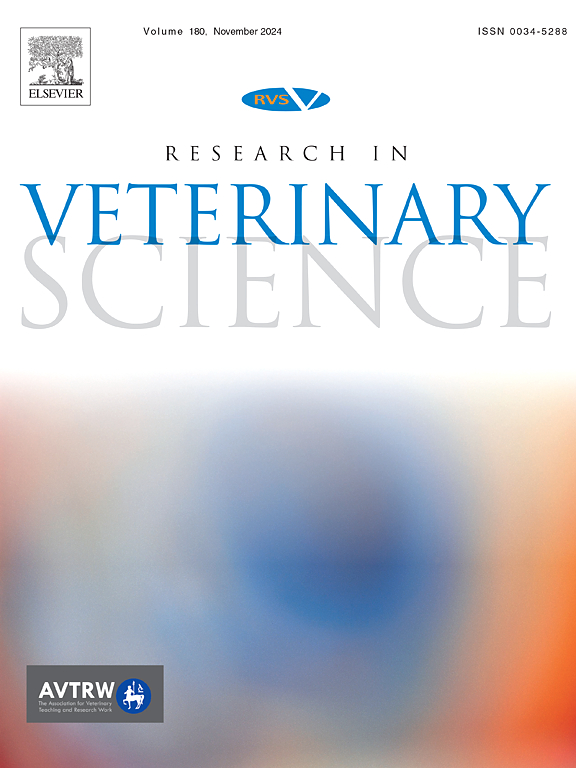重复繁殖荷斯坦牛亚临床子宫内膜炎和输卵管闭塞的患病率、危险因素和治疗方法的评估。
IF 1.8
3区 农林科学
Q1 VETERINARY SCIENCES
引用次数: 0
摘要
由于重复繁殖者(RB)综合征的生产和经济后果,本研究的目的是确定RB奶牛亚临床子宫内膜炎(SE)和输卵管闭塞(OO)的患病率和危险因素,并制定这些病理的治疗方法。对99头RB奶牛进行子宫内膜细胞学检查以评估SE (bbb50 %多形核中性粒细胞)的存在,并使用酚磺酞试验检查输卵管通畅程度。评估体况评分,并从农场软件获取每只动物的数据(胎次、产犊日期、人工授精日期、人工授精次数和产后疾病发生情况)。将SE阳性奶牛分为a)非甾体抗炎药(NSAID)、b)前列腺素F2α (PGF2α)、c) NSAID+ PGF2α治疗方案。同样地,有OO的奶牛被分配到一个处理:a)治疗胚胎,b)人工授精。SE和OO的患病率分别为22%和3%。在SE方面,logistic回归分析显示各危险因素间无显著差异。此外,在随后的人工授精中,奶牛单独或联合使用非甾体抗炎药(PGF2α)显示出更高的受孕率本文章由计算机程序翻译,如有差异,请以英文原文为准。
Evaluation of prevalence, risk factors, and therapeutic approach for subclinical endometritis and oviductal occlusion in repeat breeder Holstein cattle
Due to the productive and economic consequences of Repeat Breeder (RB) syndrome, the objectives of this study were to determine the prevalence and risk factors for subclinical endometritis (SE) and oviductal occlusion (OO) in RB cows, and to make a therapeutic approach for these pathologies. In 99 RB cows, endometrial cytologies were performed to assess the presence of SE (>5 % polymorphonuclear neutrophils), and the oviductal patency was checked using the phenolsulfonphthalein test. Body condition score was evaluated, and data from each animal were obtained from on-farm software (parity, calving date, artificial insemination (AI) date, number of AI, and occurrence of postpartum diseases). Cows positive to SE were assigned to one treatment protocol: a) Non-steroidal anti-inflammatory drug (NSAID), b) Prostaglandin F2α (PGF2α), c) NSAID+ PGF2α. Similarly, cows with OO were assigned to one treatment: a) Therapeutic embryo, b) Artificial insemination. The prevalence for SE and OO was 22 % and 3 %, respectively. Regarding SE, the logistic regression did not show any significant difference for the risk factors evaluated. Moreover, cows that were administered the NSAID, either alone or in combination with PGF2α, showed higher conception rates in the following AI (p < 0.05). Due to the low prevalence of OO, it was not possible to perform the logistic regression analysis. In conclusion, neither SE nor OO seem to be the main cause of RB syndrome in the cows under study. Additionally, when SE is diagnosed as the main cause of RB syndrome, treatment with NAISDs seems to increase conception rates.
求助全文
通过发布文献求助,成功后即可免费获取论文全文。
去求助
来源期刊

Research in veterinary science
农林科学-兽医学
CiteScore
4.40
自引率
4.20%
发文量
312
审稿时长
75 days
期刊介绍:
Research in Veterinary Science is an International multi-disciplinary journal publishing original articles, reviews and short communications of a high scientific and ethical standard in all aspects of veterinary and biomedical research.
The primary aim of the journal is to inform veterinary and biomedical scientists of significant advances in veterinary and related research through prompt publication and dissemination. Secondly, the journal aims to provide a general multi-disciplinary forum for discussion and debate of news and issues concerning veterinary science. Thirdly, to promote the dissemination of knowledge to a broader range of professions, globally.
High quality papers on all species of animals are considered, particularly those considered to be of high scientific importance and originality, and with interdisciplinary interest. The journal encourages papers providing results that have clear implications for understanding disease pathogenesis and for the development of control measures or treatments, as well as those dealing with a comparative biomedical approach, which represents a substantial improvement to animal and human health.
Studies without a robust scientific hypothesis or that are preliminary, or of weak originality, as well as negative results, are not appropriate for the journal. Furthermore, observational approaches, case studies or field reports lacking an advancement in general knowledge do not fall within the scope of the journal.
 求助内容:
求助内容: 应助结果提醒方式:
应助结果提醒方式:


